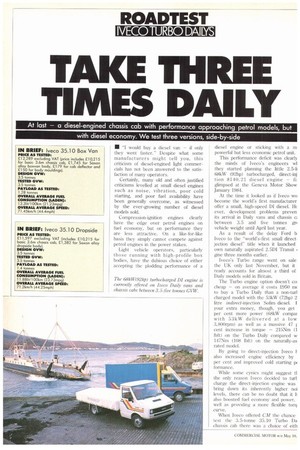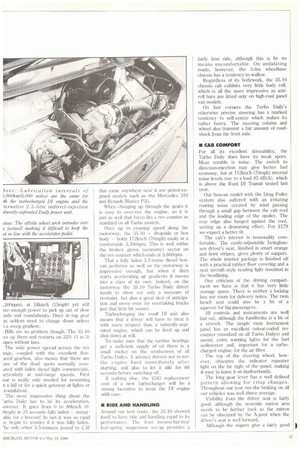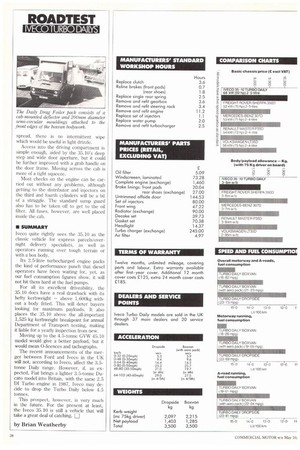TAKE TH REE TIMES DAILY
Page 34

Page 36

Page 37

Page 38

If you've noticed an error in this article please click here to report it so we can fix it.
At last — a diesel-engined chassis cab with performance approaching petrol models, but with diesel economy. We test three versions, side-by-side
MI "I would buy a diesel van — if only they went faster." Despite what some manufacturers might tell you, this criticism of diesel-engined light commercials has not been answered to the satisfaction of many operators.
Certainly, many old and often justified criticisms levelled at small diesel engines such as noise, vibration, poor cold starting, and poor fuel availability have been generally overcome, as witnessed by the ever-growing number of diesel models sold.
Compression-ignition engines clearly have the edge over petrol engines on fuel economy, but on performance they are less attractive. On a like-for-like basis they simply cannot compete against petrol engines in the power stakes.
Light vehicle operators, particularly those running with high-profile box bodies, have the dubious choice of either accepting the plodding performance of a diesel engine or sticking with a In powerful but less economic petrol unit.
This performance deficit was clearly the minds of Iveco's engineers wl they started planning the little 2.5-li 68kW (92hp) turbocharged, direct-inj tion 8190.21 diesel engine — fi glimpsed at the Geneva Motor Show January 1984.
At the time it looked as if Iveco wo become the world's first manufacturer offer a small, high-speed DI diesel. 1-1( ever, development problems preven its arrival in Daily vans and chassis a between 3.5 and five tonnes gri vehicle weight until April last year.
As a result of the delay Ford b Iveco to the "world's-first small directjection diesel" title when it launched own naturally aspirated 2.501 Transit 4 gine three months earlier.
Iveco's Turbo range went on sale the UK only last November, but it ready accounts for almost a third of Daily models sold in Britain.
The Turbo engine option doesn't coi cheap — on average it costs 1'950 nx to buy a Turbo Daily than a non-turl charged model with the 53kW (72hp) 2 litre indirect-injection Sofim diesel. your extra money, though, you get per cent more power (68kW compat with 53kW delivered at a low 3,800rpm) as well as a massive 47 I cent increase in torque — 215Nm (1 lbft) on the Turbo Daily compared w 197Nrn (108 lbft) on the naturally-as rated model.
By going to direct-injection Iveco I also increased engine efficiency by per cent and improved cold starting pi formance.
While some cynics might suggest ti the only reason Iveco decided to turl charge the direct-injection engine was bring down its inherently higher noi levels, there can be no doubt that it h also boosted fuel economy and power, well as providing a more flexible torq curve.
When Iveco offered CM the chance test the 3.5-tonne 35.10 Turbo Da chassis cab there was a choice of eith a dropside or boxvan. "Why not test both?" was our answer, and for good measure Iveco threw in another 35.10 boxvan fitted with its own aerodynamic Drag Foiler system — available to boxvan operators for an extra 229 — to see if it really can save fuel.
Although we normally test vehicles up to 3.5 tonnes GVW around our 137Iun (85 mile) light van route, Iveco is pushing the Turbo Daily as a machine for high mileage operators. We therefore decided to give it a real workout around our 338km (210-mile) Welsh truck route which includes over 113km (70 miles) of top-speed motorway running.
• PERFORMANCE With its low-height body, the 35.10 dropside — not surprisingly — turned in the best fuel consumption with a good overall average of 11.88 lit/100km (23.73mpg). The results for the two boxvans were even more impressive, however, considering their higher drag. The standard version returned a creditable 15.01 lit/100kin (18.82mpg), but its twin with the Drag Foiler pack gave an excellent 13.3 litilOOlun (21.23mpg) overall figure.
Just in case these figures need any further underlining, it is worth remembering that the average petrol-engined 3.5tonne boxvan does well to return 17.65 lit/100km (16mpg), while on the motorway its consumption can be as high as 23.5 lit/100km (12mpg).
As the 35.10 is the only 3.5-tonne turbocharged diesel chassis cab currently in the UK, direct comparisons are not easy. However, it certainly measures up well against the more aerodynamic 4.6-tonne GVW Volkswagen I:1'45D panel van with the 76kW(102hp) six-cylinder turbo diesel engine. This returned 13.86 lit/100km
(20.37mph) over the same route in September 1984.
Closer analysis of the fuel figures for the two boxvans reveals more interesting facts. On urban running, at speeds of up to 80km/h (50mph), the Drag Foiler provided a fuel saving of over 15%. On the motorway, however, it dropped to just over zlek .
This difference is not as paradoxical as it may seem. At 113km/h (70mph) the deflector kit, rather than save fuel, allows the Daily boxvan to maintain a higher speed more easily, which naturally uses up more derv, Cut down the speeds, and the wind resistance, and the deflector kit starts to save money again.
On our Welsh route the total fuel saving
produced by the Drag Foiler packt worked out to around 13%. This met that running on a similar mix of A-road motorways an operator will need to col between 51-63,000km (32-39,000 milt before the cost of the package (229) recovered in fuel savings. For the hij mileage operator, however, this sho not prove a problem.
So much for the pounds and peni what is the Turbo Daily like to drive? C word sums it up nicely: 'lazy'. With 681 to play with, and 215Nm of torque, t Turbo Daily is just about the easiest li commerical to drive on the market. third, fourth and even fifth gear on t level, the DI engine will lug down 1,500rpin (peak torque is delivered
,200rpm), at 24km/h (15mph) yet stil we enough power to pick up out of slow ends and roundabouts. Once in top gear DU seldom need to change down unless 1 a steep gradient.
Hills are no problem though. The 35.10 es up them and restarts on 33% (1 in 3) opes without fuss.
The wide power spread across the rev Inge, coupled with the excellent fivepeed gearbox, also means that there are one of the dead spots normally assoLated with laden diesel light commercials, articularly at mid-range speeds. First ear is really only needed for restarting n a hill or for a quick getaway at lights or roundabout.
The most impressive thing about the 'urbo Daily has to he its acceleration, owever. It goes from 0 to 80km/11 (0Omph) in 25 seconds fully laden — remarable for a boxvan! In fact it was so rapid ,e began to wonder if it was fully laden. he only other 3.5-tormers tested by CM that came anywhere near it are petrol-engined models such as the Mercedes 310 and Renault Master P35.
When changing up through the gears it is easy to over-rev the engine, so it is just as well that Iveco fits a rev counter as standard on all Turbo models.
Once up to cruising speed along the motorway, the 35.10 — dropside or box body — holds 112kmih (70mph) easily at a comfortable 3,500rpm. This is well within the broken green (economy) sector on the rev counter which ends at 3,800rpm.
That a fully laden 3.5-tonne diesel boxvan performs so well on the motorway is impressive enough, but when it then starts accelerating up gradients it moves into a class of its own. Indeed, on the motorway the 35.10 Turbo Daily driver needs to show not only a measure of restraint, but also a great deal of anticipation and move over for overtaking trucks just that little bit sooner.
Turbocharging the small 1)1 unit also means that a driver will have to treat it with more respect than a naturally-aspirated engine, which can be fired up and shut down at will.
To make sure that the turbine bearings get a sufficient supply of oil there is a small sticker on the windscreen of all Turbo Dailys. It advises drivers not to rev the engine hard immediately after starting, and also to let it idle for 60 seconds before switching off.
If nothing else, the £245 replacement cost of a new turbocharger will be a strong incentive to treat the 1)1 engine with care.
• RIDE AND HANDLING
Around our test route, the 35.10 showed itself to have ride and handling equal to its performance. Thc front torsion-barirear leaf-spring suspension set-up provides a fairly firm ride, although this is by no means uncomfortable. On undulating roads, however, the 3.6m wheelbase chassis has a tendency to wallow.
Regardless of its bodywork, the 35.10 chassis cab exhibits very little body roll, which is all the more impressive as antiroll bars are fitted only on high-roof panel van models.
On fast corners the Turbo Daily's otherwise precise steering has a marked tendency to self-centre which makes its rather heavy. The steering column and wheel also transmit a fair amount of roadshock from the front axle.
• CAB COMFORT
For all its excellent driveability, the Turbo Daily does have its weak spots. Most notable is noise. The switch to direction-injection may give better fuel economy, but at 112krnth (70mph) internal noise levels rise to a loud 85 dB(A), which is above the Ford DI Transit tested last year.
Our boxvan model with the Drag Foiler system also suffered with an irritating roaring noise created by wind passing through a small gap between the cab roof and the leading edge of the spoiler. The rear edge also banged against the roof, setting up a drumming effect. For £179 we expect a better fit.
The cab's interior is reasonably comfortable. The easily-adjustable Isringhausen driver's seat, finished in smart orange and fawn stripes, gives plenty of support. The whole interior package is finished off with a practical rubber floor covering and a neat aircraft-style reading light mounted in the headlining.
One criticism of the driving compartment we have is that it has very little storage space. There is neither a locking box nor room for delivery notes. The twin bench seat could also be a bit of a squeeze for big passengers.
All controls and instruments are well laid out, although the handbrake is a bit of a stretch. The simple main instrument panel has an excellent colour-coded rev counter (standard on all Turbo Dailys) and useful, extra warning lights for the fuel sedimenter and, important for a turbocharged engine, for the air filter.
The top of the steering wheel, however, obscures the indicator repeater light on the far right of the panel, making it easy to leave it on inadvertently.
The long gear lever has a well defined pattern allowing for crisp changes. Throughout our test run the braking on all our vehicles was well above average.
Visibility from the driver seat is fairly good, although the nearside mirror arm needs to be further back as the mirror can be obscured by the A-post when the driver's seat is well forward.
Although the wipers give a fairly good spread, there is no intermittent wipe which would be useful in light drizzle.
Access into the driving compartment is simple enough, aided by the 35.10's deep step and wide door aperture, but it could be further improved with a grab handle on the door frame. Moving across the cab is more of a tight squeeze.
Most checks on the engine can be carried out without any problems, although getting to the distributor and injectors on the third and fourth cylinders will be a bit of a struggle. The standard sump guard also has to be taken off to get to the oil filter. All fuses, however, are well placed inside the cab.
• SUMMARY
Iveco quite rightly sees the 35.10 as the classic vehicle for express parcels/overnight delivery specialists, as well as operators running over tough terrain or with a box body.
Its 2.5-litre turbocharged engine packs the kind of performance punch that diesel operators have been waiting for, yet, as our fuel consumption figures show, it will not hit them hard at the fuel pumps.
For all its excellent driveability, the 35.10 does have a real drawback with its hefty kerbweight above 1,600kg without a body fitted. This will deter buyers looking for maximum payloads. It also places the 35.10 above the all-important 1,525 kg kerbweight breakpoint for annual Department of Transport testing, making it liable for a yearly inspection from new.
Moving up to the 4.5-tonne GVW 45.10 model would give a better payload, but it would mean 0-licences and tachographs.
The recent announcements of the merger between Ford and Iveco in the UK will not, according to Iveco, affect the 3.5tonne Daily range. However, if, as expected, Fiat brings a lighter 3.5-tonne Ducat° model into Britain, with the same 2.5 DI Turbo engine in 1987, Iveco may decide to drop the Turbo Daily below 4.5 tonnes.
This prospect, however, is very much in the future. For the present at least, the Iveco 35.10 is still a vehicle that will take a great deal of catching. LI
by Brian Weatherby
































































